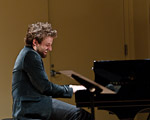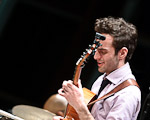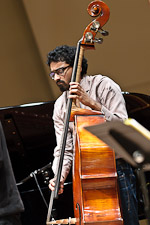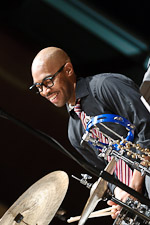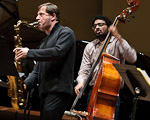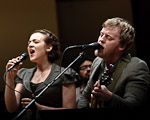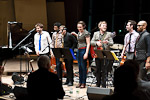 |
|
Photos by Rudy Lu |
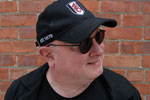 ERIC HARLAND GROUP ERIC HARLAND GROUPHelen Filene Ladd Concert Hall Arthur Zankel Music Center Skidmore College Saratoga Springs, NY February 18, 2011 by J Hunter Picture a drum circle… and I don’t mean one of those ridiculous Iron John situations where men attempt to “release their Inner Warrior”, or some such psychobabble. I’m talking about the drum circles you’ll see on the lawn at Freihofer’s Jazz Festival, where it’s nothing but an expression of joy and where the beat starts is probably miles away from where it ends. That’s the only way I can describe what the Eric Harland Group did at the Zankel Center, and that’s after living with Brain Cramp for two days after the show. It was just that deep, and just that intense. We saw the beginnings of Harland’s creative concept back in 2008, when he brought most of this group to Skidmore’s Filene Recital Hall. He then took it over to France (adding saxman Walter Smith III to the mix) and recorded the band at Paris’ Sunside Club and at the Jazz-en-Tête Festival. The result was Voyager: Live by Night (Space Time Recordings, 2010), which is an import disc… probably because the dizzying compilation of musical tangents gave stateside record execs Brain Cramp, too. And while Voyager is unquestionably amazing, the music is still nearly three years old; Harland hasn’t stood still since then, and what we saw here wasn’t just miles away from Voyager – it was light years away. Harland was happily direct in his opening remarks:. “We never know what’s gonna happen.” What happened first was bassist Harish Raghavan starting in the clear, making Zankel vibrate with the resonance he brought to Kurt Elling’s Tanglewood set last summer. Harland works with ace bassists Matt Penman and Reuben Rogers, but Raghavan’s sound and content puts him firmly on that level. Slowly, the rest of the band joined into a group meditation, with Harland shaking chimes while pianist Taylor Eigsti worked through chords and guitarist Julian Lage plucked selected strings. Sax magician Chris Potter came in last, giving us a thimbleful of what we were about to receive from him; then Harland found a groove that everyone could come together on, and the first tune (or, to be precise the first melody) was well and truly joined. Harland has said his music is all about segueways, but it’s really all about listening, and all about bridges. The bridges that connect each piece were built by one of the musicians, and everybody got a chance to play with the hammer and nails, much to our appreciation. It’s impossible to say who did the best, because every single solo spot was utterly riveting, and that never happens! The actual pieces (which were charted out, though I think those were just placeholders or bullet points) do have frameworks, but mostly it’s action and reaction and expanding on thoughts. Sometimes there’s conversation, but mostly it’s Harland giving his people (and himself) the space to go out on the ragged edge and see if gravity can be defied. As it turns out, it can – multiple times. An unbound Chris Potter is something to behold. Every time I think he’s reached his peak – either with the Dave Holland Quintet or with Chris Potter Underground – Potter finds a new gear and blows me away again. His spotlight moment had people gasping and howling, and his contributions to the group pieces were simply titanic. I said back in ’08 that this group let Eigsti escape the “Next Big Thing” tag and just let his freak flag fly; it’s almost three years later, and his amazing development has him playing with the kind of happy abandon that is Aaron Parks’ stock-in-trade. Lage had the “Next Big Thing” rubbish thrown at him, too, although his efforts as a leader have been much more satisfying than Eigsti’s. With the Harland Group, Lage’s singular sound (It could be acoustic, but it’s SO NOT!) and outside-the-box attack gives Harland’s curveballs even more tumble. Lage also showed how acoustically perfect the space was: When he tapped his feet during his solo spot, you could hear it in the back of the hall. Harland’s music mirrors his mind-melting playing style, which utilizes every square inch of his kit. It’s so outside the box, it can’t be charted. He simply hears things others don’t – which may explain his surprising choice to play support for alt-folk songwriters Becca Stevens and Josh Mease during the second set. I couldn’t get next to it, but judging by his 1000-watt smile, Harland sure could. Maybe three years from now, it’ll all make sense. J HUNTER is a former announcer/producer for radio stations in the Capital Region and the Bay Area, including KSJS/San Jose (where he was Assistant Music Director/Jazz Programming) and Q104 WQBK/Albany. He is a frequent contributor to the web site All About Jazz and to the monthly music magazine State of Mind. He currently resides in Clifton Park. |
